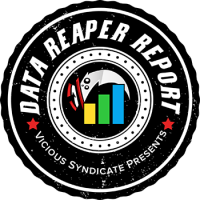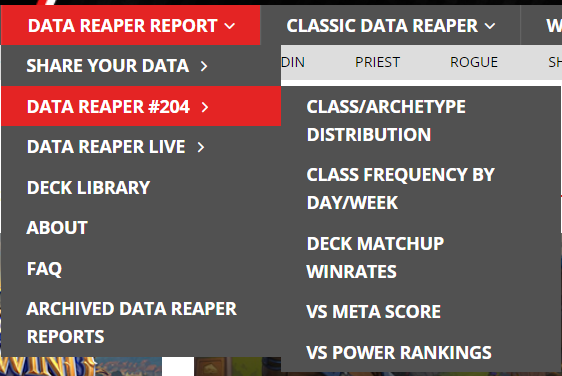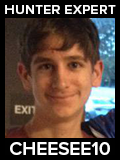
Welcome to the 228th edition of the Data Reaper Report! This is the first report for Voyage in the Sunken City.
Contributing to the Data Reaper project through Hearthstone Deck Tracker or Firestone allows us to perform our analyses and to issue the weekly reports, so we want to wholeheartedly thank our contributors. Without the community’s contributions, there would be no project. Contributing data is very easy, so if you enjoy our content and would like to make sure it remains consistent and free – Sign up!
Quick Links
Class/Archetype Distribution | Class Frequency | Matchup Winrates | vS Power Rankings | vS Meta Score | Class Analysis & Decklists | Meta Breaker of the Week | How to Contribute | Credits
Number of Games
| Overall | 755,000 |
| Top 1K Legend | 21,000 |
| Legend (Excluding Top 1k) | 82,000 |
| Diamond 4 to 1 | 104,000 |
| Diamond 10 to 5 | 137,000 |
| Platinum | 118,000 |
| Bronze/Silver/Gold | 293,000 |
Reminder About Our Graphs
- The screenshots added to this report do not make up all of the available data. You can click on each graph to take you to the original tableau file which contains more filtering options. You can also navigate to these graphs through the website’s toolbar as shown below:

Class/Archetype Distribution
[TABS_PRO id=57032]
Class Frequency
[TABS_PRO id=57033]
Class Frequency Discussion
A new expansion launched, rotation occurred, and yet we’re getting a familiar feeling from the days of Onyxia’s Lair. Ramp Druid is a very popular deck, and has become extremely popular at top legend, where the meta is most advanced in its development. The new Sunken City cards have assembled a new shell for Kazakusan that feels a bit like playing Handlock with big threats in Miracle Growth, Naga Giants and Ivus, as well as stabilization tools in Kelpkeeper and Earthen Scales. The treasure dragon can’t come down as quickly as before due to limited ramping as well as a significant number of non-dragons in the deck, but it’s still the ultimate closer for Ramp Druid once it gets close to fatigue. Bits of aggressive Druids see play, but the loss of Arbor Up has discouraged this direction.
Mage is an entirely new class this year, using minions as core parts of their strategies, and two tribes play a key role. Mech Mage is very popular at lower ranks and gradually declines on the climb. Naga Mage shows the opposite trend, peaking at top legend, with high level players being most interested in its challenging game plan.
Quest Warrior exploded on the first couple of days of the expansion, with a clean, lower curve build that suited its needs perfectly. However, we have already noticed a significant decline in its presence at top legend, leading us to suspect its behavior is not too different from what we’ve seen from the archetype in the past. We’ll have to watch its performance. Control Warrior is around with numerous builds and high experimentation. Compared to Quest Warrior, it’s nowhere near refined.
Pirate Rogue is another common ladder opponent. Its popularity pattern likens a typical Rogue deck rather than a typical pirate deck, as it becomes progressively more popular as you climb ladder. However, the powerful Rogue set seems to have pushed this one deck, and all other Rogue archetypes are nowhere to be found.
Demon Hunter was probably the class that players were least excited to experiment with as a collective. However, a shift has begun to occur. The class is picking up traction at higher levels of play, and that influence is trickling down. Aggro DH is at the center of attention, with Fel DH taking a backseat.
Behind all the hype surrounding its core set additions and its new set, Priest is trying to figure out how to win Hearthstone games. Shellfish Priest, which aims to fatigue opponents by repeatedly copying and reviving Selfish Shellfish before playing Xyrella the Devout, is the most popular strategy that has emerged. Switcheroo Priest looks to abuse Switcheroo by swapping stats between Fin Twin and Deathwing. Quest Priest is trying to figure out a Reno build. Other decks are also around in smaller numbers: Silence, Bless, Dragon, and Boar.
Hunter hasn’t changed much on the surface. There’s Quest Hunter, with two familiar variants. There’s Face Hunter, with beasts rotating out and Nagas coming in. Big-Beast Hunter is quickly fading after initial interest in the first couple of days.
Shaman is another messy class, but with one generally clear idea. The Burn Shaman cluster is extremely diverse, basically ranging from more value to more burst potential. Murloc Shaman is spotted but is quickly being abandoned.
Paladin displays three main strategies. Mech Paladin is the tribal, simple-to-build deck that emerged first. Reno Paladin is an attempt to leverage Lightforged Cariel with the healing swing of Reno, but this deck disappears at top legend. Holy Paladin, or Control Paladin, attempts to leverage the holy spell support the class has received, and uses Mr. Smite alongside buffs to finish off opponents.
Warlock is the one class that looks sort of dead at launch. Its waning interest as you climb ladder is concerning. High level players are barely touching it anymore. The Abyssal Curse and Murloc support packages are being passed over.
[TABS_PRO id=57034]

[TABS_PRO id=57035]
vS Meta Score
[TABS_PRO id=57036]
vS Power Rankings Discussion
Once again, we’ll remind you that early expansion aggregated win rates are only meaningful in the context of refinement. Let’s dig into every class to understand its prospect in the context of both its performance and scope for improvement.
- Druid
- If you thought Ramp Druid dominated Onyxia’s Lair with its 50% win rate, we have some bad news. Ramp Druid in the Sunken City is more dominant than its previous iteration has ever been. Its threat density backed up by Kazakusan is impossible to deal with for other late game strategies. Think Handlock with Demon Seed before any nerfs occurred.
- What’s more is that countering Druid in the current format is much more difficult to do as well. Only a handful of aggressive decks are fast enough to consistently beat it just 60% of the time. That’s a major difference compared to Alterac Valley, and so Ramp Druid comfortably sits at Tier 1, looking like an immovable object at the top of the meta.
- Ramp Druid’s matchups against many other faster decks are around 50-50. This would be fine if the deck didn’t demolish slower decks. We would like to see its late game dominance addressed rather than weakening its faster matchups, as doing the latter will likely lead to a hyper polarized format not too different from what we’ve seen just a few weeks ago. Ramp Druid should work harder to win late game matchups.
- There is one counter to Ramp Druid coming from its own class. We have identified a Beast Druid build with Tier 1 potential in the current format. That win rate may relax to Tier 2, but it’s the hardest available counter to Ramp Druid. It does have some major issues in other matchups (such as Shaman), so we don’t think it’s a clear meta breaker.
- Demon Hunter
- To the surprise of many, Aggro DH has emerged as the primary answer to Ramp Druid’s dominance. Its favorable matchup against the late game tyrant, combined with dominant early game matchups, makes it the strongest choice for ladder from Diamond 4 and above. This deck has two variants that perform well (‘Naga’ and ‘Token’). There are multiple clear counters to Aggro DH, but all of them get destroyed by Ramp Druid, so its success is enabled by the developing environment that’s defined by Druid. Malfurion is helping his brother out.
- Fel DH is very likely to develop into a Tier 2 deck in the current meta, though it does suffer from major issues due to the popularity of Ramp Druid. It has a small advantage in the DH mirror, and a better matchup into some decks that counter Aggro DH (like Quest Hunter/Control Warrior). Fel DH falls short to Aggro DH in almost every other relevant matchup, especially when it comes to its struggles against Druid. A nerf to Druid could open things up here.
- Mage
- Naga Mage doesn’t seem to deliver results. It’s a deck with a very high skill ceiling based on its improving performance at higher levels of play, but it’s no Garrote Rogue. Its performance isn’t showing gradual improvement. In fact, its win rate is regressing and it’s about to fall off to Tier 4 at top legend after hovering around the 50% mark just a few days ago. There is some room for refinement, but it might not be enough.
- Mech Mage is another deck that’s free falling at higher levels of play, and we wouldn’t be surprised to see it eventually languishing at Tier 3, or even worse. Tribal decks all seem to have popped off at the launch of the expansion since they were easy to build, but refinement of the field is catching up and their low skill ceilings and predictable play patterns are being exposed. Expect Mech Mage to continue to be a popular and successful deck at large portions of ladder, but one that becomes noticeably absent from top level play.
- Warrior
- Speaking of decks that are in freefall, let’s talk about Quest Warrior. This deck was an absolute menace on day 1 of the expansion, displaying a win rate of around 60% throughout ladder. However, a crash in its performance has begun to accelerate at higher levels to the point it might eventually sink into Tier 4 at top legend. At competitive play, Quest Warrior might be unplayable. The problem is that Quest Warrior is maintaining an insane win rate at lower ranks. The disparity is enormous and even bigger than we’ve seen from the deck before. We’re talking about a near 60% win rate below Diamond 4, while exceeding the 60% mark at Gold and below. There is no sign of declining win rates at these ranks. These are insane numbers that may require intervention.
- Control Warrior doesn’t seem to be doing so well, but the archetype is very unrefined. It is likely to significantly improve in its performance over the next week should Demon Hunter rise to prominence and Quest Warrior disappears from top level play. In fact, we suspect that Tier 2 is a real possibility for this deck at top legend. At lower ranks, where Quest Warrior is popular, it’s going to be a continuing struggle.
- Rogue
- Rogue is stuck on Pirate Rogue and nothing else. In addition, Pirate Rogue’s future is not looking too bright, with its win rate declining over time along with all the other tribal decks, but perhaps less dramatically. We expect it to remain a decent, Tier 2 performer throughout most of ladder, but it may get worse at top level play, where the meta should become exceedingly ruthless.
- Priest
- Priest is looking very bad. Shellfish Priest is not producing the results some may have expected it to deliver. There might be some refinement issues, but it’s hard to envision the deck making such a massive jump in win rate. Another important point is that the deck shows no improvement whatsoever at higher levels. There’s no skill trajectory even remotely visible. Switcheroo is the best performing Priest deck and it’s still Tier 4 and can hardly be considered a Hearthstone deck. Other Priest decks exhibit a win rate in the 30’s. Is it a wrap or is Priest just hard to figure out amongst all the tools it was provided with? We’ll give it some time.
- Hunter
- Face Hunter is another reliable Ramp Druid counter, but its matchup spread is far worse than Aggro DH. It also gets destroyed by DH, so we can see its performance becoming progressively worse, especially at higher levels of play. Another deck that could be collapsing under the weight of oppression.
- Quest Hunter has stronger chances to survive if Aggro DH spikes in play, as it is a decent counter to it and has an incredibly strong overall matchup spread. The problem is, of course, a terrible Ramp Druid matchup that’s significantly holding it back. Quest Hunter is already showing dominance in the tournament scene thanks to the option of a Druid ban, and we suspect it could break out and become dominant on ladder if Druid gets nerfed. Could become the next tyrant. Watch out for this one.
- Shaman
- Burn Shaman is suffering from a slow refinement phase, but its best build is estimated to be Tier 2 today. This is one deck that could survive the harsh environment, but its standing against other strong decks in the field isn’t too good. Ramp Druid is now a clear favorite in the matchup, and it’s still suffering greatly against Quest Hunter. Many of its better matchups are also waning.
- Paladin
- Mech Paladin is in a similar position to other tribal decks. Its win rate is collapsing at higher levels of play, while it will likely remain a decent competitor in other sections of ladder. Holy Paladin should become the class’ choice at higher levels, where it won’t meet as many Quest Warriors. It has a good matchup against Aggro DH, as well as Control Warrior/Quest Hunter, Aggro DH’s other counters. However, much like Warrior and Quest Hunter, it crumbles under the weight of Ramp Druid and is unable to find consistent ladder success as a result.
- Warlock
- Warlock looks done and dusted. Murloc Warlock is unlikely to be competitive, while Curse Warlock seems unplayable. The class is dead on arrival, unlike the whimpering Priest that still exudes some hope. Something drastic has to be discovered or else.
Class Analysis & Decklists
Demon Hunter | Druid | Hunter | Mage | Paladin | Priest | Rogue | Shaman | Warlock | Warrior
In what feels like a continuation of Alterac Valley, Ramp Druid is the most influential deck in the format. However, during the last expansion, it was kept in check effectively by aggressive decks. This isn’t the case now, with the archetype looking extremely dominant and difficult to beat thanks to the reduced power level of the format as well as its new survivability tools. There are a couple of reliable answers to Ramp Druid, but its late game is unbeatable and makes every slower matchup a relative breeze.
In what is likely to be Ramp Druid’s final form, we feature a potential build for the current meta. Battlemaster is very powerful and underplayed. It fits the deck’s playstyle perfectly, as Ramp Druid is essentially Stormwind Handlock. You develop big threats while drawing cards, and if these threats are dealt with, you have your own Demon Seed quest reward in Kazakusan, which makes sure you always win the late game and can never get fatigued.
Battlemaster helps you close out games faster by punishing an opponent who leaves up your big threats. Double Oracle is core and is essential to consistently churn out threats (running one copy of Oracle is a clear mistake). Druid of the Reef is stronger than Wrath as a removal option that synergizes with Oracle. Cutting Wrath means that we can run one Jerry Rig Carpenter, making Nourish a decent keep in the mull as we’re less concerned with Carpenter becoming a dead draw later. Smothering Starfish is a great tech in the mirror thanks to Oracle/Ivus, and against both Shaman and Mage because of their freeze effects.
Beast Druid is one of the sleeper decks in the format should Ramp Druid continue to dominate, as it might be its most reliable counter once again. Spell-heavy builds of the archetype, including the one we theorycrafted and others like the Alterac iteration, haven’t worked out. Instead, a minion-dense Gardens build with Kazakus is showing great promise. If you’re wondering why Bottomfeeder isn’t included, it’s because the card seems to suck.
Aggro Demon Hunter might be the strongest deck in the format and the best counter available to Ramp Druid. There are two popular variants seeing success.
The first is the Vanilla “Naga” variant. We’ve found that this deck should be more “Fel” than it is “Naga”. Wayward Sage is a terrible card in the deck, and even Lady S’theno seems very weak. Predation is still a great card in the deck, so we’ve added Treasure Guards to fill our Naga quota. Treasure Guard is a promising target for Drek’Thar that we’d like to see more data on. Metamorfin is a sleeper strong card in the deck that’s significantly better than both Irondeep Trogg and Beaming Sidekick. Fel Barrage provides more damage from hand and helps activate the murloc more consistently. Bone Glaive has turned out to be an important finisher for every aggressive deck centered on Drek’Thar. This build is all about snowballing a few early game minions and then dealing a lot of damage off the board.
The second is the Token variant. This build is more board-centric and carries less damage from hand. Feast of Souls is terrible, so we replaced it with Spectral Sight. We also don’t like Coordinated Strike and opted for Troggs, which should be a natural fit in this deck. It’s a bit strange they’re not utilized in this variant already.
Fel Demon Hunter is okay, but the more we tried to refine it, the more we realized it’s basically an Aggro Demon Hunter that decided to drop Drek’Thar for Jace. Aldrachi Warblades are far weaker than Bone Glaive, while Pufferfist is superior to Glaiveshark. The upside of dropping Drek’Thar is that we can run School Teachers, which are very strong in Demon Hunter. The problem is that our matchup against Druid gets much worse. We’ll have to see if the meta changes to the point other slower strategies become successful, and then Fel DH will have some longevity advantages over its aggressive counterpart. A Druid nerf would help this archetype a lot.
Naga Mage is an interesting deck, but unfortunately one that doesn’t seem to perform very well at any level of play. It displays the highest skill ceiling in the format, but even that doesn’t seem to be enough at the moment. Perhaps there’s some room for refinement.
Overall, we think Habugabu’s #1 legend build is close to the mark when it comes to the Ignite variant. We’re not impressed with Hot Streak or Siphon Mana. Multicaster helps Ignite perform better. We diverge from Habugabu by picking Azshara over Zola. Zola is pretty good in the Siren turn, and awful outside of it, while Azshara is a stronger standalone card. There’s also the option to run both, but we’re very intrigued with a Naga that doesn’t see much play but looks very promising.
Preliminary results suggest that Treasure Guard could be nuts. While it does cost 1 more mana compared to Rainbow Glowscale, meaning it isn’t ‘free’ with Spitelash Siren, it is a stronger standalone minion and an incredible protector of your Naga board. It makes it so difficult for aggressive decks to be able to clear your Spitelash Siren, but most importantly, it soaks three Whelp attacks from Scale of Onyxia and holds off Kelpkeeper. That’s back breaking in the matchup and worth exploring for this reason alone.
An alternative take running Wildfire over Ignite is also producing interesting results. Ignite is generally a weak win condition, so Wildfire could be a more reliable way to win off the board. Mordresh is strong against Druid too.
We don’t have data on Magister Dawngrasp, but in a deck running Wildfire, it’s a card that could be very strong. We opted for Treasure Guards but there’s an option listed to improve the slower matchups.
Building Mech Mage is more straightforward. We’ve found that it’s not worth running Dungeoneer to tutor Gateway. You’re better off running Fireballs to finish opponents off after the initial board onslaught. Ini Stormcoil has proven to be very strong in mech decks. Irondeep Troggs are likely going to become core once everyone reads this report and realizes just how good Druid is. The Balinda/Amulet build is not good.
Quest Warrior looks like an absolute menace at most ranks of ladder, though we expect it to barely be playable at top legend. It is very effective at preventing players who lack fundamentals from misplaying since the game plan is extremely straightforward and spelt out, but the deck has very little player agency, which means it falls flat against stronger players who know how to exploit its predictable play patterns.
The correct build of the archetype appears to be the one we featured in our theorycrafting article, card for card. We thought that Nellie would be a strong card in the deck, but her performance surprised even us. It is the 2nd strongest card in the deck after Mr. Smite!
Control Warrior is attempting a couple of different approaches, though all of them greatly struggle against Ramp Druid and Quest Warrior, which means the archetype isn’t having a great time.
The Kazakusan variant wants to be a bit more proactive and run Nagas. School Teacher is a great card for the archetype and Azshara suits the deck too alongside Enforcers. Guard the City helps you activate Enforcers on-curve. Nellie is insanely good in this archetype too.
The Galvangar variant looks similarly powerful, utilizing From the Depths alongside Obsidiansmith. Finley is very strong in this deck due to his synergy with From the Depths. Nellie is nuts, we’ve said it three times now. Just play the card.
Pirate Rogue is a fine deck in the format, but not exceptional. Hooktusk looks like bait in the current meta, as she’s utterly horrid in faster matchups. You’re better off focusing on having the strongest early game possible. Swordfish and Vessel can deal enough damage to kill your opponent before Hooktusk is ever relevant. Preparation is key in developing Vessel earlier. Crabatoa is the 2nd best card in the deck, after Mr. Smite. Fogsail Freebooter is an underplayed card that looks pretty good.
There’s not much else in the class. It’s pirates or bust.
Priest looks rough. There’s a lot of hype over Shellfish Priest but results don’t back it up whatsoever. We will note that a common error in building the deck is cutting Lightmaw Netherdrake. This tanks the deck’s win rate hard. We also think Shadow Word: Ruin is essential at dealing with Druids, and we would make room for it by cutting Cleric of An’she. This allows us to keep Brann and Zola around for the big combo turn with Xyrella the Devout and Priestess Valishj. Still, we’ll be surprised if this deck gets out of Tier 4 in the current format.
Switcheroo Priest is a bit of a joke and not a funny one either. The deck makes for an incredibly toxic gameplay experience, and we wouldn’t be surprised to see Switcheroo changed because of what this deck is doing in Wild with Stonetusk Boar and The Darkness.
There’s a way to make it semi-competitive in Standard too, by having a backup plan with Call of the Grave, Amulet of the Undying and Xyrella. Just find a high value deathrattle and go from there. It’s not a great plan, but it still means the game isn’t automatically lost if you’ve drawn one of your minions before playing Switcheroo, or if your Fin Twin ended up getting cleared. Instead of conceding on the spot (which most players immediately do), you can keep going to steal some wins.
Boar Priest is another interesting deck that’s just beginning to appear. Its initial results aren’t great, though PocketTrain did hit #1 legend with it just today. We think running Lightbombs helps.
Hunter is predictably utilizing the same archetypes it did before rotation and both look okay. Initially, we saw the Multicaster build of Quest Hunter performing better than the Drek’Thar variant, but the cause was messy experimentations with the latter. Players are attempting to incorporate some sort of Naga package into the deck, with lukewarm results.
It might be best to simply utilize the list we’ve theorycrafted last week, as it has been performing very well. Marked Shot is pretty good while Candleshot is absolutely core. This leaves the Explosive Traps to possibly be replaced by Treasure Guards as the only tweak we might end up making depending on the value of Explosive. Generally, drawing minions is something this deck doesn’t want to do. Only Raj Naz’jan looks like an exception.
Face Hunter is a good counter to Ramp Druid but isn’t as well rounded as Aggro DH. Replace Gnome Private with Bloodseeker, Beaming Sidekick for Amalgam of the Deep, and you’re good to go.
Burn Shaman seems to have survived rotation thanks to Bioluminescence and is the most promising direction available to a class that looks very lackluster outside of it. The current iteration attempts to abuse Bolner and Brann in combination with the deck’s battlecry minions. School Teacher is a fantastic addition to the deck and even allows for a crazy burn combo if you can get your Nagaling to cast Bioluminescence. Coral Keeper has been a massive disappointment, and a depressing fact is that Irondeep Trogg is a better card for the deck. We’re a little sus of Radiance of Azshara but it barely makes the cut.
Paladin is hanging in there and should benefit from the success of Demon Hunter. Holy Paladin looks competitive without going all out on the Smite OTK. It’s enough to cast a Righteous Defense or two and land some Cariel buffs to finish off your opponent, so Gangplank Divers aren’t needed. The deck has strong defensive tools, so it can survive for a long time until it can execute. Battle Vicar ended up being quite strong alongside Shimmering Sunfish. We like Bannerman for the extra draw and consistency in finding Mr. Smite. Queen Azshara is not good in this deck. Survive until you find Cariel/Smite should be your primary concern, and this is also the way to beat Druids since Righteous Defense is perfect against them.
Mech Paladin mostly needs a couple of tweaks to help it close out games better. Despite being a handbuff deck, we’re underwhelmed by Alliance Bannerman. Vindicator doesn’t seem worth running to find Radar Detector either. Mr. Smite, Battlemaster, Ini and Samuro go in. Keep the mech count high.
Warlock sucks. A lot. Murloc Warlock is a weak aggressive deck that’s likely going to fade away with the meta’s refinement. But we will say that Gigafin is the best card in the deck, and it’s missing from a lot of builds. You want to maximize your murloc count as much as possible to benefit from buffs.
Curse Warlock looks unplayable. Many builds attempt to utilize Mithril Rod, but the absence of card draw makes it a liability often. The curse cards are just too weak. Phylactery Warlock builds look atrocious regardless of their win condition, and it just seems like the class is about to go into hibernation for a couple of months until it gets something in the mini-set, or buffs earlier.
Once the meta settles down, we suspect that Ramp Druid and Aggro DH will sit head and shoulders above the rest of the field, especially at higher levels of play where the gap in power is only widening. Ramp Druid defines the resource end of the meta spectrum. Aggro DH defines the initiative end of the meta spectrum. The first set of balance changes for the Sunken City is likely just around the corner, so their dominance may not last long. Demon Hunter might even dodge nerfs, but there’s little chance of Ramp Druid avoiding the hammer.
Enjoy them while you can.
Preparing our weekly article requires a significant amount of time and effort from many individuals. We would like to wholeheartedly thank our current Patreons, whose generous donations help us fund computing and server costs.
vS Gold is our membership plan aimed to support our efforts towards improving our content and data analysis while receiving some bonuses and extra features.
Tier 3+ Patrons
Special thanks to Leo G, Aaron B, Jed M, Drew M, Alan J, Zolstar, Sean H, Steve F, Andrew N, Alonso P, James Y, Je-ho, Stephen H, William H, 1RiceBowl1, Alex S, PeejTreon, Josh G, Matthew H, Bruno B, Amir, Matthew P, amenbrotep, Karhu, Fisherington, Christopher N, Eric F, Eric L, BraveLittleStove, Lime, Fireproofflame, Kaushal, David, Joshua B, Jeff C, Pi, Reharl, Scott L, Jeff P, Mark P, Keith C, The Big Dawg, nburst, Alex S, Jess M, Peter, Lepton, Bob L, Gary W, Philthy, Charlah R, Chocobo, Tim B, Chad K, and Hayden S for supporting us this month.
Contributors
Here are all the people that participated in bringing you this edition of the vS Data Reaper Report:
































As always, you guys are the best. Thanks for the report!
since multicaster is not a naga and it costs 4, while treasure guard at least gives you 1 mana back, draws you a card and is a good anti aggro card, would you consider cutting multicasters for guards? i think the decks draws very well even without it, as well as it can create spells outisde of your deck, and it has 4 extra nagas from amalgams and teachers.
i tried a version of the deck without multicasters and did really well. i just never find time to play multicaster. and if you want to draw against aggro, you basically give them a free turn